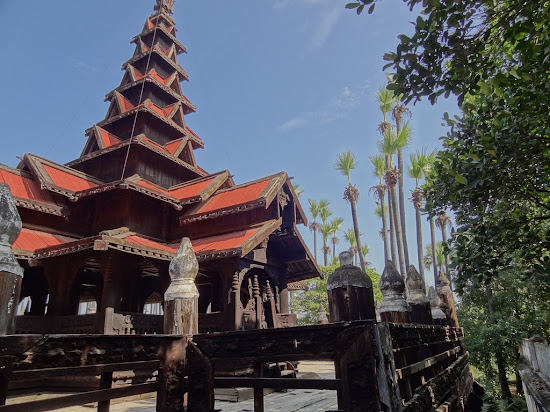Amarapura comes from Pali, it means "City of Immortality". During the Konboung period (1783-1821 and 1842-1859) it was twice the capital of Myanmar. But then Amapura got victim of mortality: In February 1857 King Mindon began building Mandalay as his new capital, 11 km north of Amarapura. He reused material from Amarapura. The palace buildings were dismantled and moved by elephants to the new location, and the city walls were pulled down. Therefore Amapura today is a township of Mandalay, known for silk and cotton weaving and bronze casting.
But Amapura is also famous for the U Bein Bridge: A 1.2 km long wooden footbridge, the longest teak bridge in the world. It spans the Taungthaman Lake. The bridge on 1086 pillars was built from wood reclaimed from the former royal palace in Inwa. Read: 1000 Amazing Places: U Bein Bridge.
 Picture by Greg Walters
Picture by Greg Walters Picture by imke.stahlmann
Picture by imke.stahlmannU Bein Bridge
 Picture by patrikmloeff
Picture by patrikmloeff Picture by Andurinha
Picture by AndurinhaView from U Bein Bridge
 Picture by imke.stahlmann
Picture by imke.stahlmannWedding on U Bein Bridge
 Picture by Mark Abel
Picture by Mark AbelU Bein Bridge before 6 am.
 Picture by llee_wu
Picture by llee_wuSunset at U Bein Bridge.
 Picture by Stephan Rebernik
Picture by Stephan RebernikJust a moment on U Bein Bridge
 Picture by marhas
Picture by marhasKyauktawgyi Pagoda:
 Picture by Antoine 49
Picture by Antoine 49 Picture by Trevor Mills
Picture by Trevor Mills Picture by Mat Maessen
Picture by Mat Maessen Picture by Anzoine 49
Picture by Anzoine 49 Picture by Antoine 49
Picture by Antoine 49 Picture by marhas
Picture by marhasInwa: Formerly Ava, the capital of the Kingdom of Ava. Foundet 1364 here Mjitnge River joins Ayeyarwady River. 1783 King Bodawpaya transfered the capital to Amarapura and let Ava distroy. 1821 his grandson Bagyidaw returned and reconstructed Ava. But in 1841 an earthquake destroyed the city and Amarapura became the capital again. The zigzagged outer walls of Ava are popularly thought to outline the figure of a seated lion.
Bagaya Kyaung: A wooden monastery founded in 1834 by King Mindon, in Innwa.
 Picture by Thomas Z H Zhu
Picture by Thomas Z H Zhu Picture by gorbulas_sandybanks
Picture by gorbulas_sandybanks Picture by gorbulas_sandybanks
Picture by gorbulas_sandybanks Picture by gorbulas_sandybanks
Picture by gorbulas_sandybanks Picture by Matt Werner
Picture by Matt WernerMaha Aungmye Bonzan Monastery: Built in 1818. See picture on panoramio.com.
 Picture by brussels100
Picture by brussels100 Picture by Anandajoti
Picture by AnandajotiThe basement
Besides Maha Aungmye Bonzan Monastery you discover Htilaingshin Paya, a recently restored group of stupas dating back several centuries, some to the Bagan period. See picture by samthetax and ceka01 and viedeo by hotshotmonkey.
 Picture by gorbulas_sandybanks
Picture by gorbulas_sandybanks Picture by scotted400
Picture by scotted400Lilyponds in Inwa
Nanmyin Watchtower: A leaning tower. See picture by Dexters Lab.
 Picture by antwerpeneR
Picture by antwerpeneRYedanasini Paya:
 Picture by chenevier
Picture by chenevierChinese Joss House - Kuan Yin Temple: The temple was founded in the 18th century. The original temple was destroyed by firein 1810. What you see today dates from 1847. Pictures by John Meckley.
Kyauksein (Jade) Pagoda: The pagoda made entirely of jade is nearing completion. It includes more than 10000 tonnes of the gemstone and is being built at the junction of Ygn-Mdy Expressway and Sagaing-Myitnge Road at an estimated cost of US$ 10.3 million, reports Myanmar Times. The donator Soe Naing plans to donate the pagoda to the government, reported Eleven.
.
Sagaing:
 Picture by brussels100
Picture by brussels100View of Sagaing across Ayeyarwady River
 Picture by Anthony Tong Lee
Picture by Anthony Tong LeeSagaing Hill
Umin Thounzeh Phaya:
 Picture by Tianyake
Picture by Tianyake Picture by Tianyake
Picture by TianyakeSoon U Ponya Shin Phaya:
 Picture by Tianyake
Picture by Tianyake Picture by Tianyake
Picture by Tianyake Picture by Tianyake
Picture by TianyakeKaung Hmu Daw Pagoda: Outstanding this pagoda with egg-shaped design. It has been modeled after the Ruwanwelisaya pagoda of Sri Lanka. The stupa's formal name is Yaza Mani Sula. This signifies Buddhist relics inside its relic chamber. It is said to contain the lower left tooth of the Buddha and 11 hair relics. The construction started in 1636 and was finished in 1648. The dome houses a seated 7.3 meter-high Buddha statute, carved out of white marble. The lowest terrace of the pagoda is decorated with 120 nats and devas. It is ringed by 802 stone lanterns, carved with inscriptions of Buddha's life in three languages: Burmese, Mon and Shan Yuan, representing the three main regions of Toungoo Kingdom.
 Picture by dany13
Picture by dany13Read more:
Mandalay Impressions
Mandalay Hotel Picks: Reviews by guests
Mandalay Restaurant Picks: Reviews by guests
Get around in Mandalay by Taxi
River Cruises from Mandalay to Bagan and Mingun
From Mandakay by train to Gokteik and one of the longest viaducts of the world across a canyon
No comments:
Post a Comment